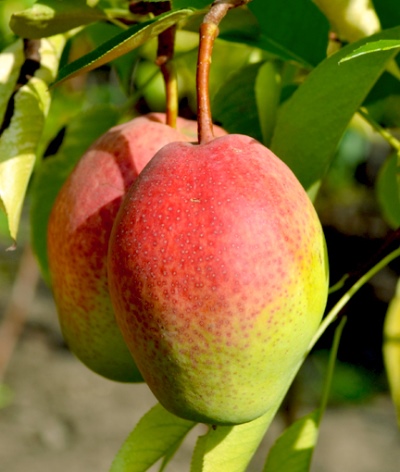
- Authors: Kyrgyzstan
- Appeared when crossing: Forest beauty x Bere winter
- Name synonyms: Kyrgyz winter, Kyrgyz late
- Fruit weight, g: 200-250
- Ripening terms: late (October)
- Appointment: dining room
- Growth type: medium height
- Yield: very high
- Transportability: good
- Crown: sparse, pyramidal
Pear Kirghiz is a compact variety obtained by amateur crossing of the Lesnaya Krasavitsa and Bere Zimny varieties. It was bred taking into account the peculiarities of the harsh steppe climate, it is distinguished by unpretentiousness in cultivation, good taste properties of the fruits. The variety has been successfully zoned not only for Kyrgyzstan, but also for the Russian Federation, it is deservedly popular among gardeners. It is found under the name Kyrgyz winter or Kyrgyz late.
Description of the variety
The Kirgiz pear is a medium-sized tree with a sparse pyramidal crown. Fruiting occurs mainly on the ringlets.
Fruit characteristics
The pears are kubarevidny, each weighing 200-250 g. Fruits are not sized, medium and large in size. At the stage of removable maturity, the skin has a greenish-yellow color, with a blurred "blush". Upon reaching full ripeness, it becomes golden yellow, with a carmine-red tone spread over almost the entire surface. The pears on the stalk are tight, the fruits are not prone to shedding.
Taste qualities
Table pears, pleasant sweet taste. There is a slight sourness. The dense juicy pulp is easy to bite. The set of taste continues during storage.
Ripening and fruiting
The variety is characterized by a late ripening period. The fruits are harvested in September-October, depending on the region where the tree grows. The first fruits are obtained 2 years after planting. Then the harvest takes place annually, on a regular basis.

Yield
According to this indicator, the Kyrgyz pear belongs to varieties with a very high yield. The collection volumes are 500-600 c / ha. The variety is considered promising for commercial cultivation. Possesses excellent transportability, can be stored in the refrigerator until March-April.
Self-fertility and the need for pollinators
The variety is self-fertile. For more abundant yields, agronomists recommend planting other pollinator varieties next to trees. Pass Crassan, Bere Ardanpon will do.
Landing
The best seedlings are annuals. They are placed in the ground in spring or autumn, outside the period of frost or extreme cold. It is best to land with two people to avoid possible discomfort. In a young tree, the ends of the main roots are pruned with a secateurs, the rest is placed in a liquid clay mash.
The choice of a place for planting is carried out in favor of a nutritious and moist soil. It's not bad if the place is well lit, not blown by through winds. When planting in partial shade, the climb will be effective, but abundant fruiting will not work. Places with a high groundwater table, lowlands, wetlands are not suitable.
A hole is dug of a sufficiently large diameter. A low mound is formed inside, a peg for a garter is driven in from the north side. A seedling with a straightened root system is placed on top of the embankment. It should be distributed over the entire fossa, without unnecessary bends and creases. The pit is filled up with a specially prepared soil substrate, layer by layer, with a slight shaking of the trunk after each stage to eliminate voids.
When planting, the graft area is left about 40 mm above the ground level. Then abundant watering is carried out, in which the root collar sags to the desired level. Garter to the support, mulching of the trunk circle is performed. After planting, it is recommended to cut a young tree at a height of 80 cm so that the crown forms on a well-ripened bud.


Growing and care
Recommendations for agricultural technology for the Kyrgyz pear are quite simple. At 1 and 2 years from the moment of planting, a thorough mulching of the soil is carried out, weeds are cut out. For the winter, the shelter is also constructed from natural materials. The layer of mulch increases to 10-15 cm, the trunk is tied with spruce branches, covered with whitewash in the late autumn period.



Disease and pest resistance
The Kyrgyz pear is highly resistant to scab and other major diseases. Not very susceptible to bacterial cancer.

Like any other fruit trees, the pear needs protection from various diseases and pests. When planting a pear on your site, you need to know in advance what diseases you should beware of. To successfully carry out the struggle, it is necessary first to correctly identify the cause of the problem. It is important to distinguish signs of disease from manifestations of the presence of insects, mites, caterpillars and other types of pests.
Resistance to soil and climatic conditions
The Kirghiz variety has high winter hardiness. He tolerates growing in low temperatures, is not afraid of strong winds. A small number of sunny days does not affect fruit set. Trees are immune to thermal burns.
Review overview
The general opinion of gardeners about this pear variety can be called positive. Almost all owners note that the trees take root well after planting, quickly and actively grow. The abundance of fruiting is also indicated. Moreover, the fruits that have lain after being removed from the branches only become tastier, gaining softness and juiciness.
The disadvantages of the summer resident variety include difficulties in collecting fruits from the upper branches. In addition, the trees attract rodents.Protection against them has to be carefully thought out.





































































